The path to financial transparency requires a strict, monthly data routine. One of the reports that contributes to this routine is the software bookings report. And it’s one of the biggest data mistakes that I see in SaaS.
Without solid bookings data, we cannot track the performance of our sales team, forecast revenue accurately, and calculate sales and marketing efficiency metrics. I talk to a lot of SaaS companies, and their bookings report is usually inaccurate.
You may not speak the bookings language if you offer self-service SaaS, but the concept is still the same and the data is still required.
Bookings data drives decisions, commissions, metrics, and so much more. You can download my bookings template at the bottom of the post and access additional free training.
What is a Booking
A booking is an executed contract between you and your customer for products and/or services. A booking is typically formalized via a contract with your customer.
The contract includes a master services or subscription agreement (MSA) and a purchase agreement (PA) or sales order (SO). Yes, the MSA contains a ton of legalese, but it’s important legalese! This can haunt you later if not done right.

The purchase agreement contains the important details of the economic terms between you and your customer. Often, these contract details are tracked in your CRM system but can also be tracked in spreadsheets if you are just starting out. The point is to track this data from the beginning! This is a common mistake. Not tracking!
For our bookings report, we need to track product line items, price, rate and quantity if transaction-based, subscription duration, and type of revenue (subscription, services, transaction, etc.). Again, this data should flow naturally out of your Closed Won report if your CRM is configured properly (free training below on this).
What Data Do We Track with a Booking?
Your bookings data will be sourced from your CRM system or a spreadsheet. The data must be precise. And we must track from day one.
At a basic level, we must understand what was sold, the price, and for how long. This data flows downstream to feed our invoicing process and as inputs to finance for your sales and marketing efficiency metrics.
It’s common to track the following data points within bookings data:
- Customer Name
- Product Name
- Quantity Sold
- Unit Price
- Total Price
- Contract Duration
- Subscription Start and End Dates
See the picture below of the data that would be itemized on your purchase agreement and in your CRM software.
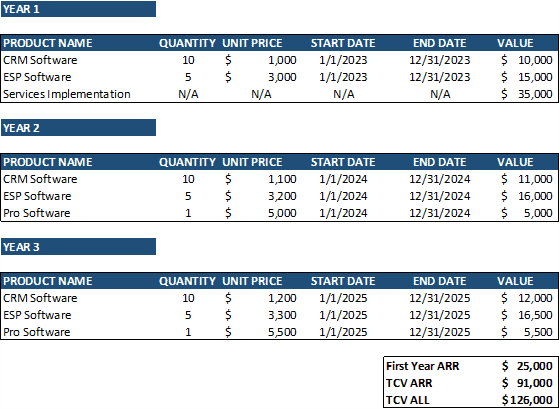
It is important to track this data by revenue stream. For example, in one deal, we can sell a software subscription and professional services. Professional services include the configuration, setup and training of the customer on our product.
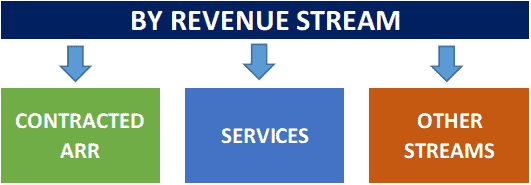
We do not want to co-mingle revenue streams in the contract details. This creates confusion in our invoicing process, revenue recognition engine, and our SaaS metrics.
We may track some combination of the following revenues streams:
- Subscription
- Variable Revenue (usage, consumption, processing, etc.)
- Professional Services
- Managed Services
- Hardware
You may offer some or all of these revenue streams. It’s important to track each revenue stream in your bookings data.
New vs. Expansion Bookings
When tracking bookings, we must distinguish between new business and expansion business. This split helps us understand sales performance, forecast revenue more accurately, and is required Cost of ARR inputs.
Often, a different opportunity record type is created in our CRM system so that we can easily separate new versus expansion. Co-mingling new and expansion will make things really messy.
When tracking new business, we report the gross value of the dollars booked. If I sell a $10K subscription to a new customer, the first-year bookings value is $10K.
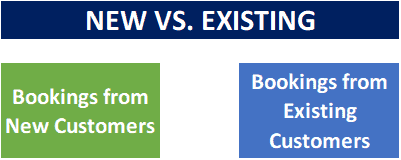
When tracking expansion business, we report the incremental increase of the upsell (selling more of the same product) or cross-sell (selling the customer a new product line).
For example, if I upsell the same customer in year 2 by selling them the “advance reporting package” for $5K per year, I must track the incremental $5K. Mid-contract expansion is usually easy to track.
Renewals and Expansion ARR
Expansion tracking may get tricky with the customer renewal process. Let’s say a customer was paying us $10K per year for three years. It’s now time to renew that customer with another three-year contract.
If we upsell the “advanced reporting package” for a $5K per year, we are going to show the new three-year contract as $15K per year. They were paying us $10K per year, but now they are paying us $15K per year.
Somewhere in our CRM and bookings data, we must capture the incremental $5K. This is the bookings number that will appear in my bookings template below in the Expansion reporting. Not the $15K.
The $5K will drive our revenue forecasting process and will be an input to the Cost of ARR Expansion.
Are Bookings a KPI?
Bookings are not a calculated metric but an extremely important data point. Everybody wants to know your bookings number. Your Board, investors, potential investors, leadership team, and finance.
It’s common to track and report bookings on a monthly basis. Hence, your bookings number for the month is the sum of all closed won deals.
This includes new and expansion bookings. However, we do report these separately and then sum in total. See my example bookings tracker below.
The bookings report is one of my top five SaaS reports. I run this report on day two or three of close once I know that sales operations had processed the opportunities for the previous month.
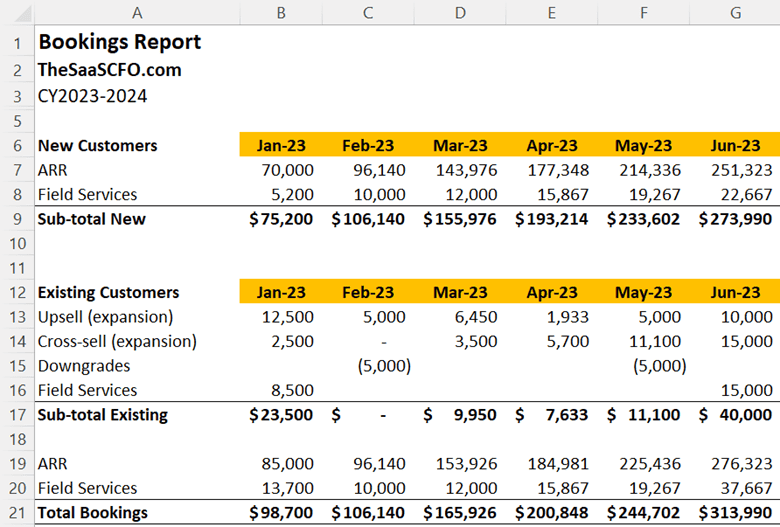
In the example report above, the SaaS company sells subscriptions and professional services to set up their customers. We are tracking new, expansion, ARR, and field services.
Don’t Make the ARR vs. TCV Mistake
We need a common unit of measurement in our bookings report. If you speak the bookings language, you probably speak on ARR terms.
In the bookings report template above, we don’t want to mix ARR with TCV (total contract value) in the numbers. If the sales team closes a one-year, two-year, and three-year contract in June and we count all of the years as bookings, I don’t know my true ARR growth.
Yes, you should definitely track TCV (PE investors will ask) but use ARR as a common measurement unit in your bookings report.
Why is Bookings Data Important in SaaS
There are so many stakeholders with bookings data. Our Board, investors, potential investors, leadership, and so on. And I guarantee your bookings data will be requested in any due diligence process.
Bookings data is important for sales team performance tracking, commissions calculations, forecasting revenue accurately, and calculating our sales and marketing efficiency metrics.

Want to calculate CAC Payback Period but you don’t know how many new customers and dollars you closed? Well, you won’t be able to calculate your CAC and your payback period.
And if we have professional services organization, we can track how much services ARR has booked and how much is in the pipeline to balance staffing needs, utilization, and future hiring in the PS org.
Bookings data is a “must-have” monthly report.
What Date Do We Use to Report a Booking?
This is a small nuance but an important nuance. What date do we use for the bookings date? I’m from the camp where we count a booking on the contract execution date.
If you and a customer sign a contract on June 15, this booking appears in my June bookings report. There is a second camp that counts a booking on the subscription start date. You can see the results from two polls below that I ran on LinkedIn.
Just be careful with a timing mismatch between your bookings date using subscription start date and when the deal was actually closed. For example, if you sign a customer in June but don’t start the subscription until December, you’ll want to be careful with how you feed your bookings data into your S&M metrics.
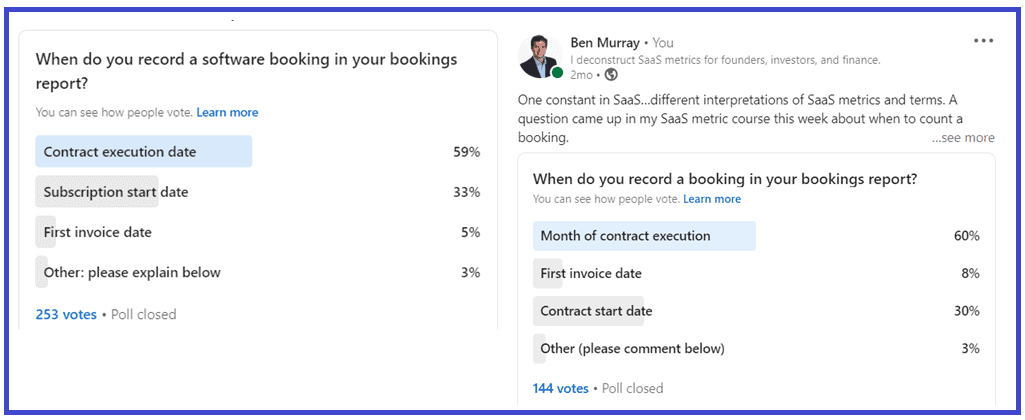
What’s the Difference Between a Booking and Billing?
Okay, so we know a booking is an executed contract between you and your customer for products and/or services. Is a booking a billing then? No, not yet!
A billing, or an invoice, occurs when we send the invoice to the customer requesting payment. Remember! A bookings is NOT a billing or revenue or cash yet. It’s the first step in the SaaS revenue cycle.
The executed contract is then passed to accounting to invoice the customer properly. Then we set up revenue recognition and eventually collect the cash.
When is a Closed Won Deal not a Booking?
We have to be careful with renewal deals. If you sign up your customer for another three-year contract but they are paying the same amount, this is a closed won renewal.
But, it will not appear in my bookings report. There were no incremental dollars gained that would change our revenue forecast or flow to our S&M efficiency metrics.
A renewal will improve our renewal rate metric, but this will not appear as a value in our monthly bookings report.
Expansion vs. Downgrade ARR
For existing customer wins, we want to track two buckets, expansion and downgrade dollars. You may even split expansion business into cross-sells and upsells if you have several product lines.
You may ask, why do I track downgrades? I track contracted downgrades in the bookings report, because a sales effort was involved in renewing that customer for a downgrade. We saved the renewal but they dropped features or product lines.
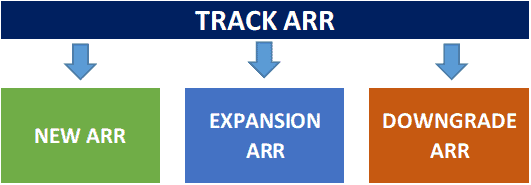
If a sales effort is not involved in the downgrade, then I don’t subtract downgrade ARR against my total bookings number for the month. It’s not fair to penalize our ARR number if customers can self-select the downgrade with no involvement from our sales team.
Tracking Bookings Counts
In SaaS, we talk a lot about unit economics. Unit economic (aka SaaS metrics) calculations require the tracking of dollars (what we just discussed above) and counts. For example, last month we won $450K in new ARR which represented five new customers. The customer is the count.
I also like to track the number of contracted expansions and downgrades. This helps me more accurately forecast revenue.
Counts are required in many SaaS metrics calculations including customer acquisition cost (CAC) and CAC Payback Period.
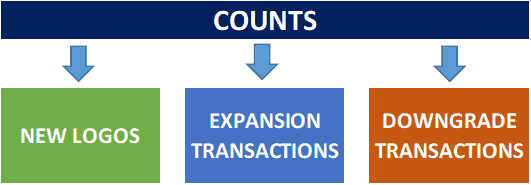
What are the Popular CRM Systems to Track Bookings Data?
I’ve run four annual SaaS tech stack surveys at this point. Here are the top players in use at SaaS companies per my survey.
Salesforce and HubSpot continue to be the dominant players in SaaS.
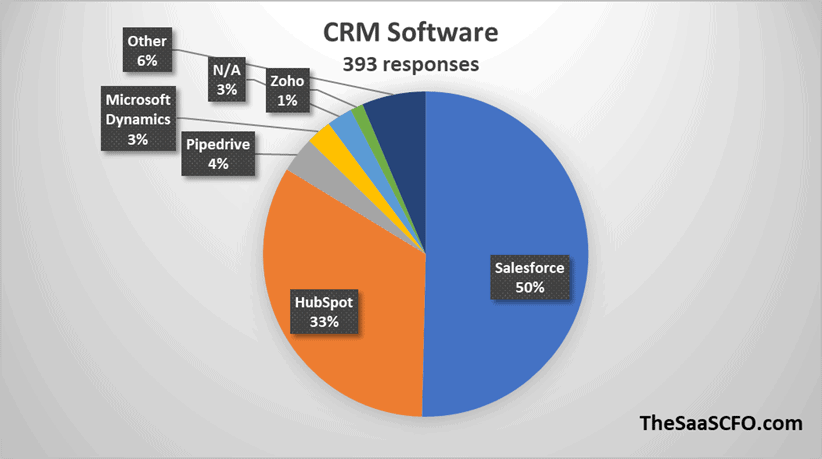
You can also see what CRM systems are used at different ARR sizes via the chart below. It will be interesting to see if HubSpot can move upmarket into Salesforce territory.
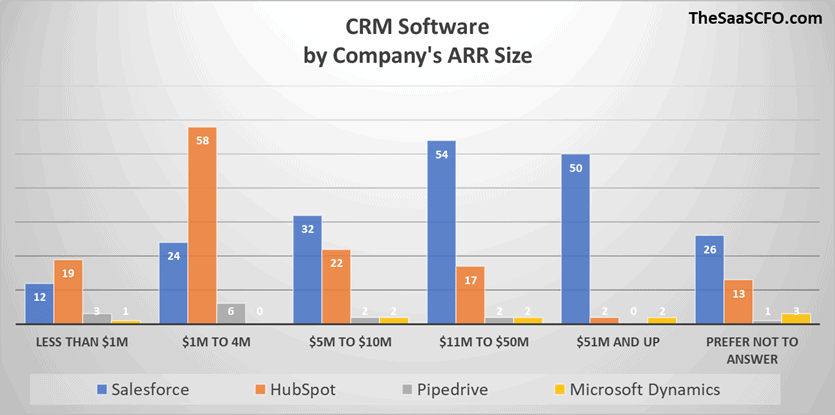
Proper CRM Setup
The proper setup of your CRM system is critical to your sales and finance processes. It captures critical data to power your go-to-market engine. We analyze it just like financial data.
The CRM area is an often-encountered weak spot when I work with SaaS teams. It creates a major blind spot that must be tackled. It’s one of the biggest data mistakes and will put you in weak position when it comes to due diligence.
Check out the free training here on how to correctly configure your CRM opportunity.
What is a Master Subscription Agreement
Back to the MSA, because this is an important legal and commercial process for sales and finance. The MSA acts as a commercial operating manual between you and your customer. It’s in place to protect both parties. Yes, you and your customer!
For example, how quickly can you terminate services if your customer does not pay? What if you infringe on intellectual property rights in your product that your customers are using? The MSA will tell how you to proceed in these cases.

The MSA is relatively static and not meant to change much or change at all with each customer you sign. The commercial terms between you and your customer are handled by the sales agreement or purchase agreement. The PA contains pricing, product line items, subscription durations, and payment terms (please make sure payment terms are clear!). The PA is the operating manual for accounting on how to provision and invoice your new customer.
A formal MSA/PA process is almost always used in a direct, outbound sales process versus self-service signup. I have witnessed founders not using any sort of agreement in their sales process. This is a mistake and can be costly. Yes, it’s a bunch of legalese but that jargon is there to protect you and your customer. Check out Salesforce’s MSA here as an example.
You check out Salesforce’s MSA here as an example.
Takeaways
We made it! You can see just how nuanced we can get with bookings tracking in SaaS companies. If Opportunities and a CRM are a part of your sales process, you must correctly track this data.
There are so many stakeholders when it comes to bookings data. It’s right up there with financial data from our accounting software.
You can download my bookings template below. And take advantage of the training I help on properly configuring your CRM opportunity.
I’d love to hear your comments below.
I have worked in finance and accounting for 25+ years. I’ve been a SaaS CFO for 8+ years and began my career in the FP&A function. I hold an active Tennessee CPA license and earned my undergraduate degree from the University of Colorado at Boulder and MBA from the University of Iowa. I offer coaching, fractional CFO services, and SaaS finance courses.
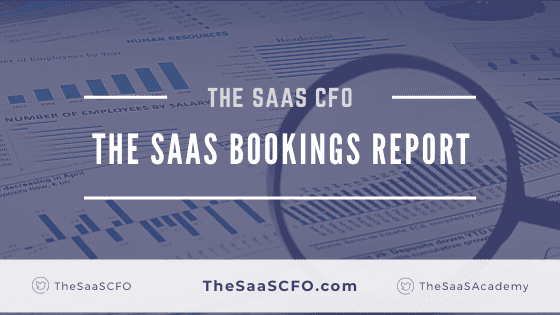

Ben,
I really enjoy your articles. I find them extremely helpful. I have a question for you regarding the recognizing of revenue for subscription contracts. In my previous startup we were told by our auditors that any deal we sign/book after the 15th of the month, the revenue associated with this deal, we shouldn’t start recognizing it until the following month. The argument came about that we were signing most of our deals towards the end of each month and to recognize a full month’s worth of revenue with only a few days remaining in the calendar month wasn’t a good policy. I’m just curious as to what you see how other SaaS companies recognize the revenue for similar transactions.
Hi Chris, I could see that but sounds like fixed assets recognition. With daily revenue recognition, I recognized starting on subscription start date regardless of when this fell in the month. Ben.